
5 Expert Approved Stretches for a Pinched Nerve in Your Lower Back
Quickly Relieve Your Pain From a Pinched Nerve in Your Lower Back in These 5 Simple Stretches:
- Pelvic Tilt
- Cat Camel
- Double Knees to Chest
- Lying Prone
- Prone Press
Nerve pain can be very uncomfortable! With this type of pain can feel so intense and sometimes unpredictable. Often times, my clients think it feels like sciatica.
What Are the Best Stretches for a Pinched Nerve in the Lower back?
Stretches for a pinched nerve in the lower back can be an effective way to treat the pain that is felt down the leg. The tissue that surrounds the nerve can cause compression, leading to pain. Stretching the muscle that may be causing the pinch can lead to relaxation and a reduction in symptoms. I have had many patients that come into the clinic with low back pain, yet their main issue is that the pain runs down the back of their leg. Most doctors put a general label of “sciatica” as a diagnosis, although it can be much more complex.
1. Pelvic Tilt
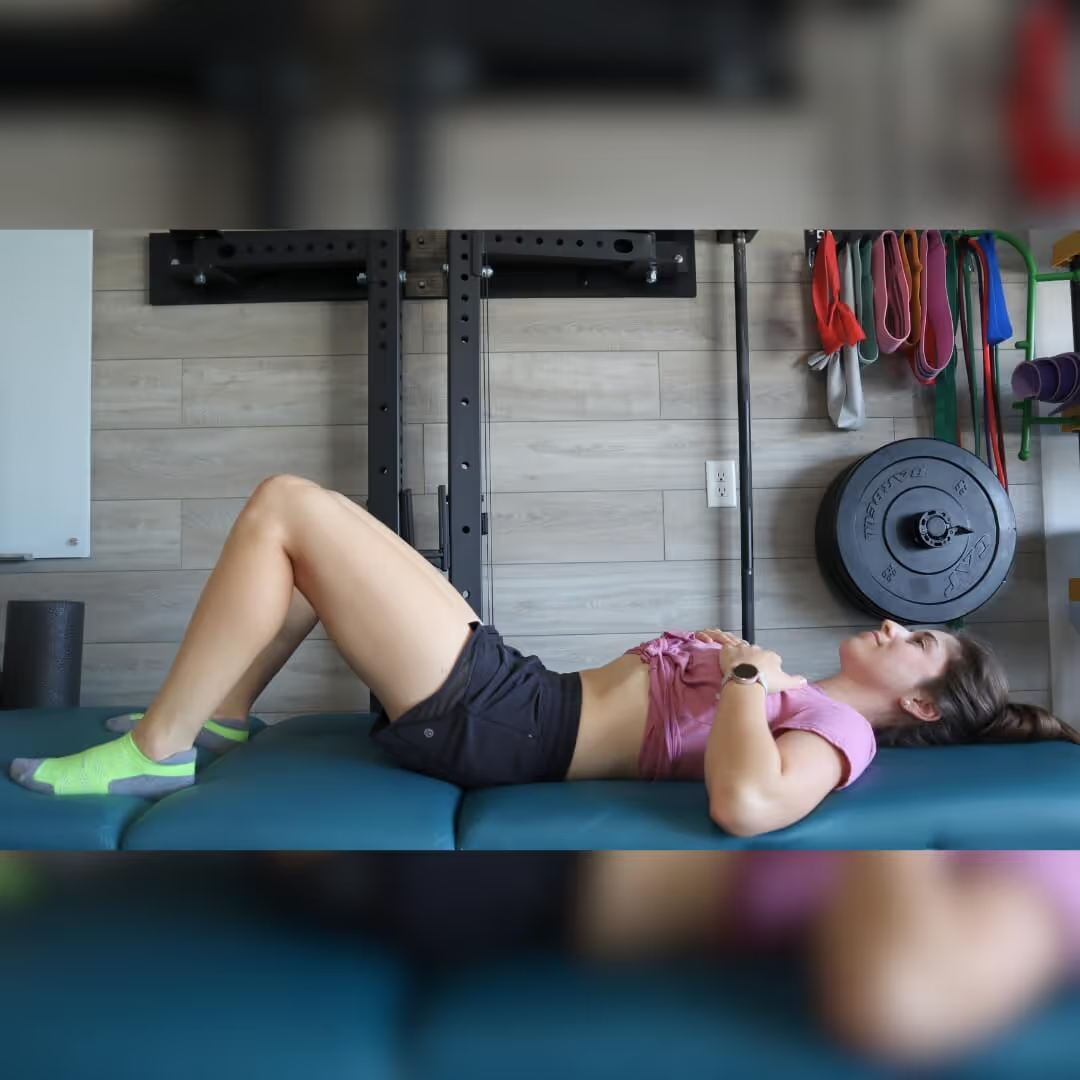
Position yourself laying down on your back with your knees comfortably bent. From here, the goal is to rotate the pelvis back. Think about the front of your hip bones “tilting” back or dumping out a bowl of fruit from your pelvis. This creates a rocking motion and helps mobilize the hips and lumbar spine.
2. Cat Camel
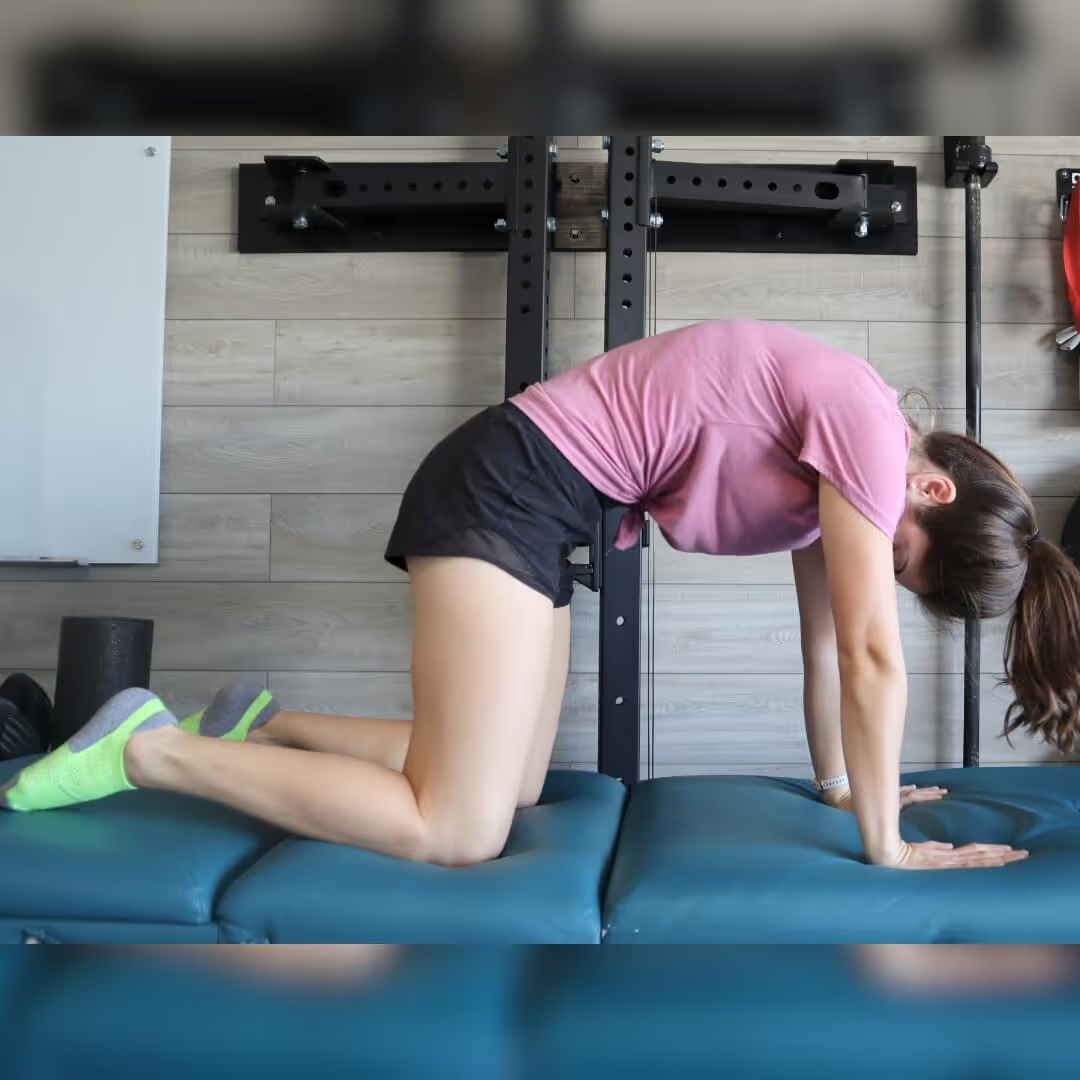
This exercise starts while on the hands and knees. Do your best to keep your arms and hands under your shoulders and knees in line with the hips. Similarly to the pelvic tilt, position the pelvis so that it tilts backwards. This will bring the back up like a cat arching their back. Start with a small range to determine how well it can be tolerated. Remember, the symptoms down the leg should not get worse. If they do, be sure to stop the exercise and move on to the next. Expect there to be some discomfort in the back, but no increase above baseline leg pain.
3. Double Knees to Chest
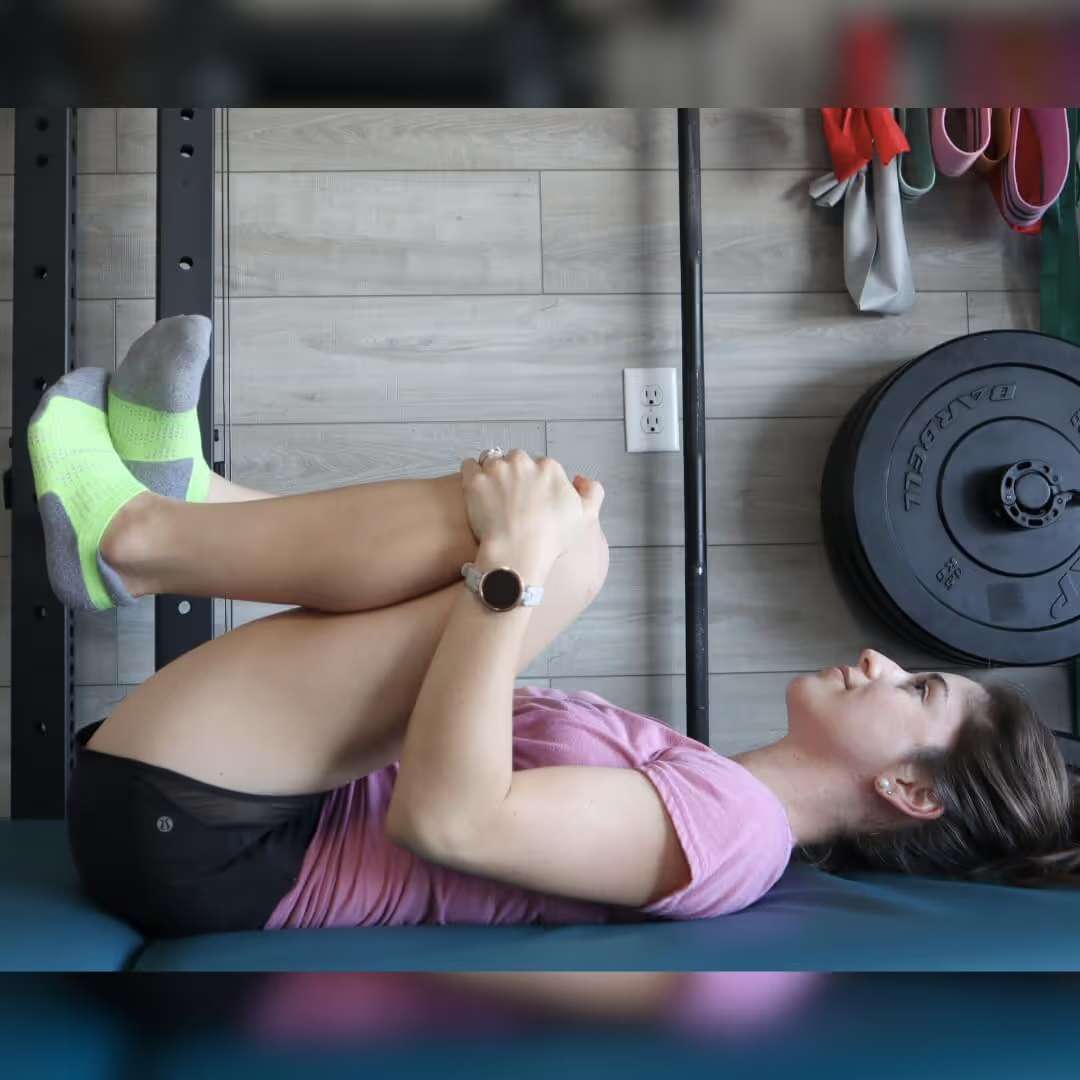
Start by laying on your back with the knees bent and feet flat on the ground. Start with one leg or both depending on what feels good for your body. Bring the knees up towards the chest and try to grab them to add over pressure. This brings the spine into a flexed position. This is a great movement to follow up the pelvic tilt.
4. Lying Prone
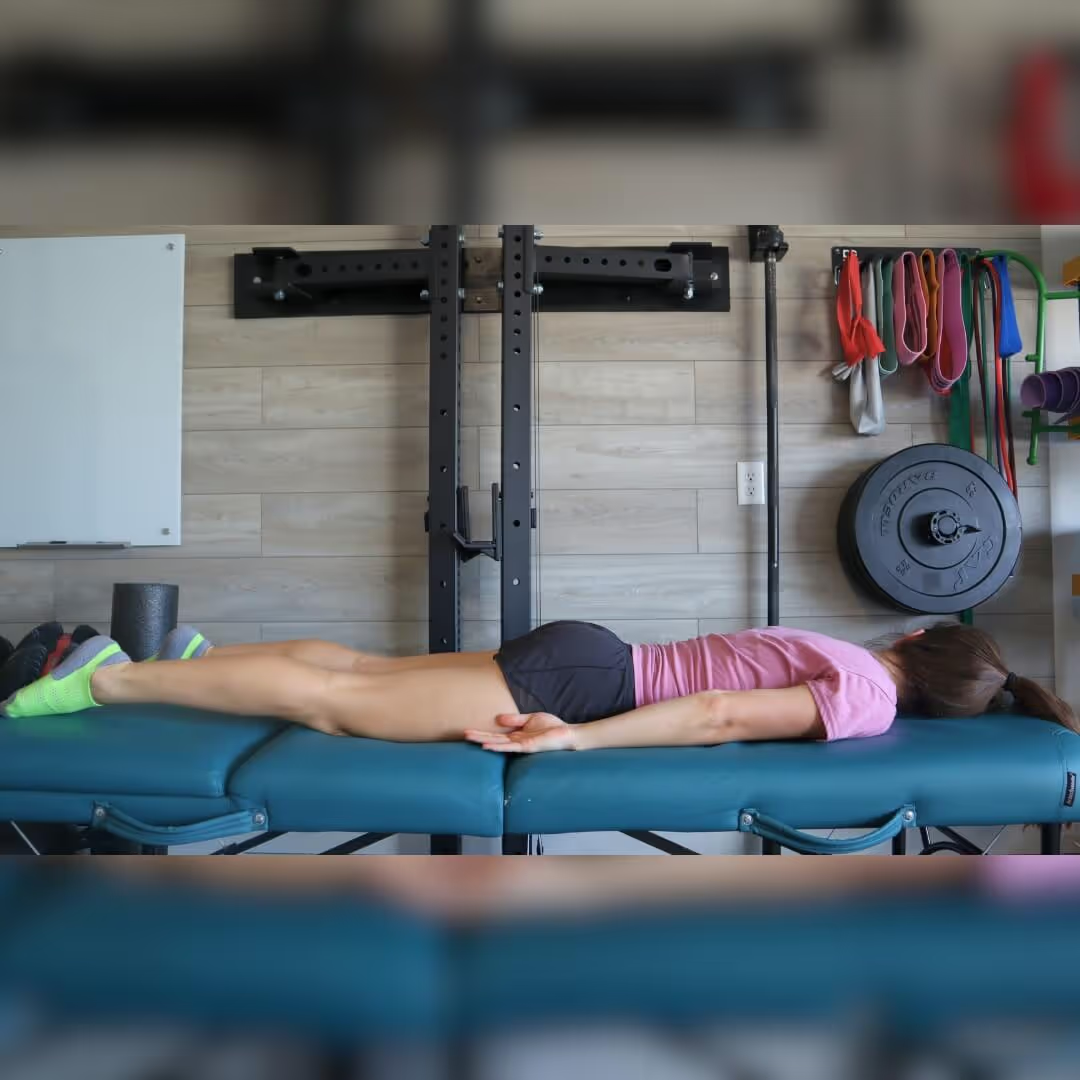
The set up for this exercise starts with just laying flat on your stomach. This brings the back into extension, which is the opposite of bending forward. This may be an uncomfortable movement at first but can be beneficial to restore mobility. This position can be progressed by placing pillows under the arms, which pushes the back further in extension. Once again symptoms down the leg should not increase above their baseline.
5. Prone Press
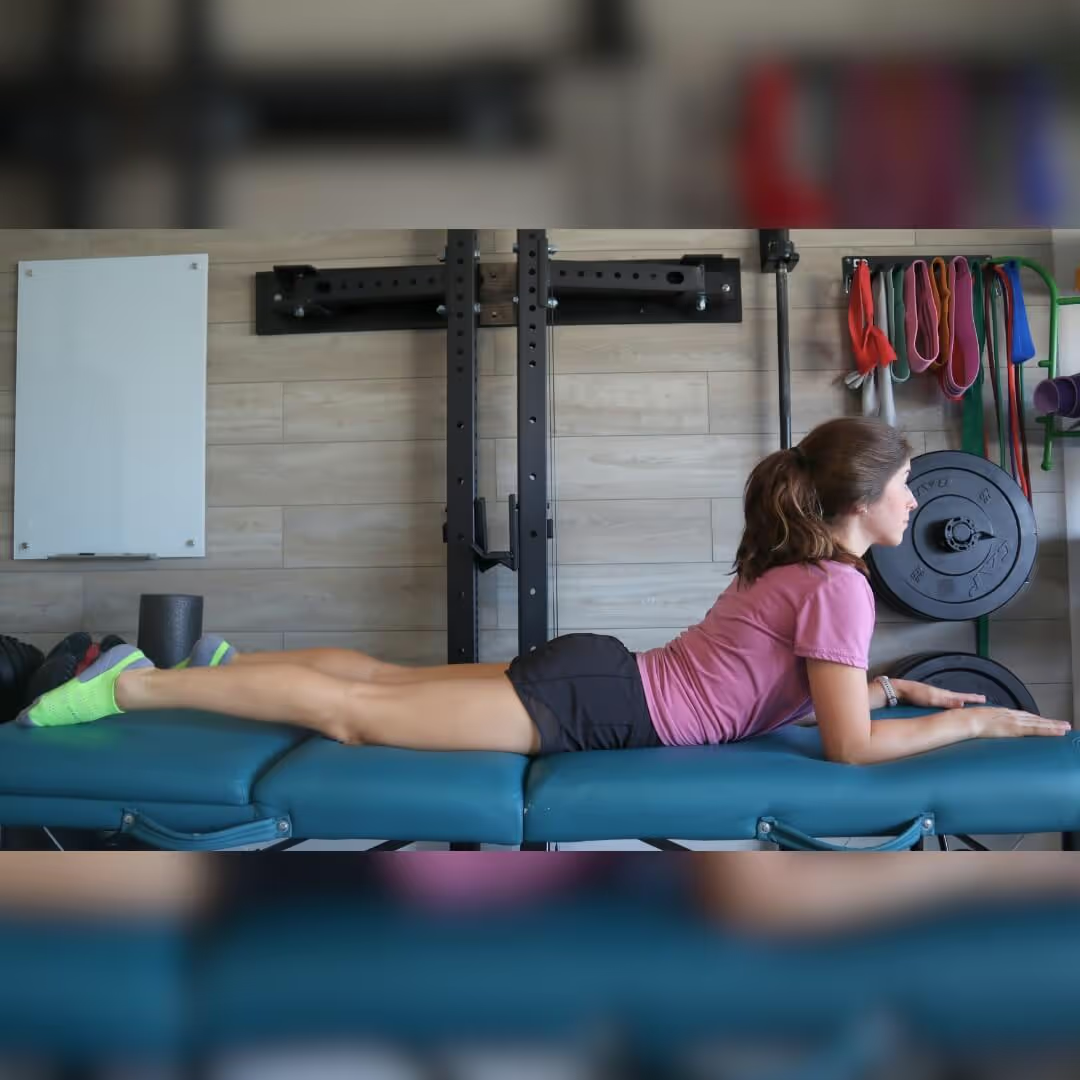
Once you have mastered the “lying prone” exercise, you can progress to the prone press up. This exercise pushes the lower back further into extension. It is good to start by just raising up on your elbows and pressing up from there. Expect to feel some pressure in the low back, but still don’t want to feel anything running down the leg. This can be progressed further to pressing up with the arms fully extended. The key to this exercise is to keep your hips down on the table or floor while pressing up the upper half of the body.
Causes of a Pinched Nerve
Typically a pinched nerve comes from two things. There are other causes but they are very rare.
- Disc Herniation: the disc either in the neck or lower back puts pressure onto th nerve root causing pain either in the arm or leg.
- Stenosis: The area around the nerve becomes more narrow and places pressure onto the nerve root causing pain in the arm or leg. Most often in those 60 or older.
If you are curious of how to tell the difference, check out this video.
Symptoms of a Pinched Nerve in the Lower Back
An irritated nerve causes the pain that people refer to as a pinched nerve. Common symptoms include burning, tingling, and radiating pain in the lower back, leg, and foot. That said, it's also not uncommon to only have pain or only have weakness. A detailed physical examination can help you figure that out!

Regardless of the cause of a pinched nerve, the conservative treatment is largely the same to start.
Pain that originates in the lower back and runs down the leg is a very common presentation for physical therapists in the clinic. This is called “radiating” pain because the central cause may be from the back but the symptoms are felt further down the body.
The term used by most people is “sciatica.” It can be caused from disc issues or space issues such as stenosis.
Sciatica refers to a very large nerve that runs from the lumbar spine all the way down the back of the leg and to the foot. Typically, the nerve is irritated at the root where it exits the spine. Other times it can be entrapped near the glutes.
When this nerve is irritated, pain is felt further away from the compression site.
Check out our favorite way to mobilize the sciatic nerve during sessions for specific patients with persistent nerve symptoms that extent outside of their back! The dosing on this one can be a bit tricky, so start slow.
Tight muscles, poor joint mobility, or even a herniated disc can all play a role in pain associated with a pinched nerve.
Is a Pinched Nerve Dangerous?
No, In a majority of cases a pinched nerve is not dangerous. Much of the problems that accompany a pinched nerve is the fear of movement leading to a loss in function.

Many people will get relief when the nerve is mobilized without any detrimental effects.
Long term neglect of a pinched nerve that doesn’t get better can lead to weakness and can even change the way people walk. In addition to poor mechanics while walking, the weakness can make the simplest task difficult.
Getting up out of the chair or going up stairs becomes a laborious task when this happens. This is a rare presentation, but something to watch out for if you’ve had these symptoms for a long time.
How Do You Unpinch a Nerve in Your Lower Back?
The feeling of unpinching a nerve is done by reducing the irritation or inflammation of that nerve. Nerves LOVE to move and NEED to move! Amazingly so, some nerves that are truly occupying a very small space don't hurt. Some nerves that show no signs or very mild signs of "pinching" or "stenosis" can hurt a ton!
The pain comes from inflammation or irritation, not the smaller house that the nerve is living in.
Most of the treatments are centered around a restoration of movement to the spine and the muscles that support it. This article will outline safe and effective movements that can get that stubborn nerve to become unpinched and allow you to live a pain free life!
Can Exercise Cure a Pinched Nerve?
Curing a pinch nerve can be as simple as doing the right exercises as the right time combined with time.
Yes, I have seen many clients report 100% improvement with exercise. I often prescribe nerve glides to assist not only moving the nerve but giving it an environment in which to heal. Here Is the deal. To reduce nerve pain you must follow these rules:
- Stay consistent - It often takes doing these every day for a month to notice a difference
- Listen to your body - They should never make you feel worse
- Do enough reps - 20-30 reps each leg
- Combine with walking program 20-30 minutes a day, everyday
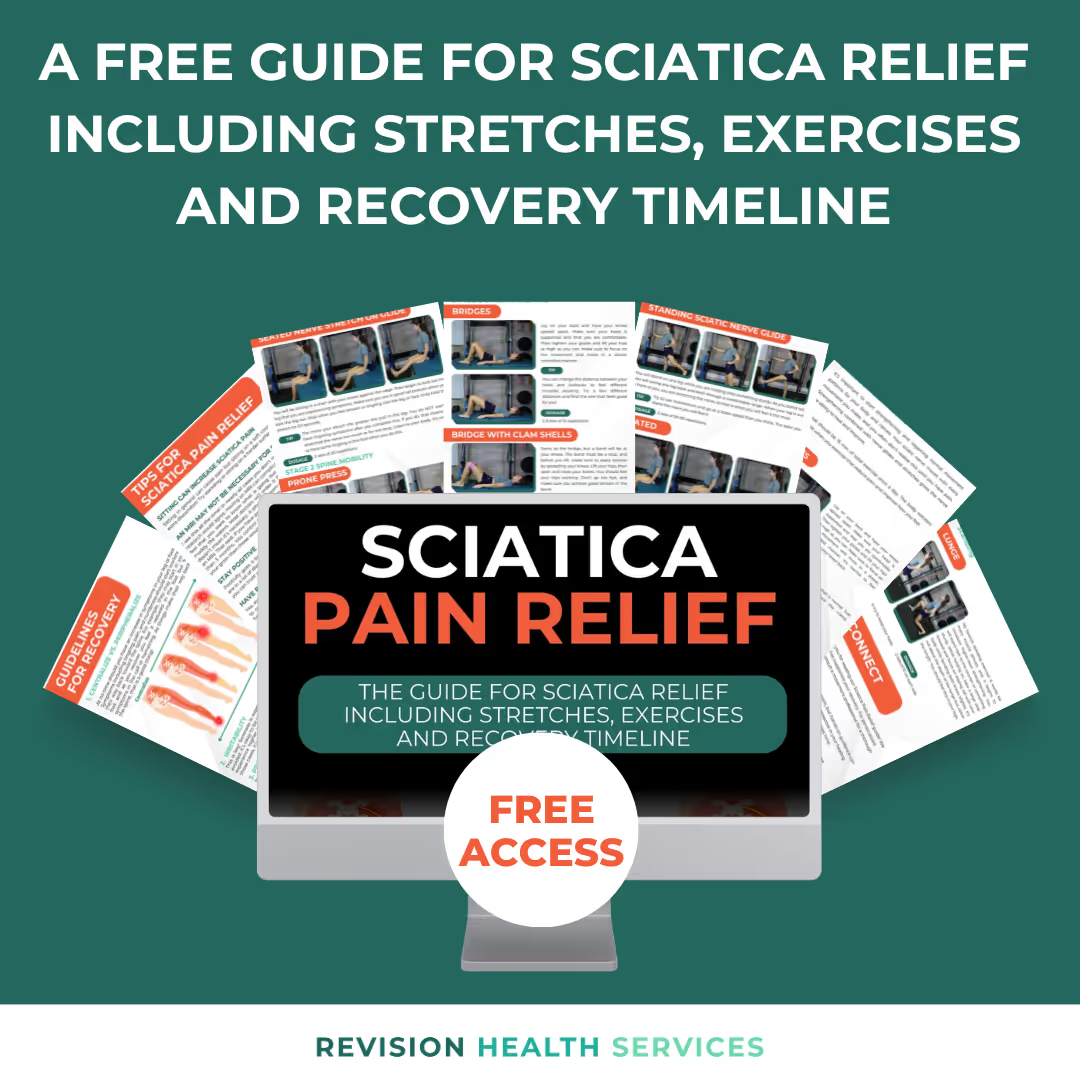
Can You Stretch Out a Pinched Nerve?
You can stretch a pinched nerve. In fact, the evidence says we should do it!
Nerves are made to be stretched, pulled, and even compressed. Like everything else when it comes to our body, it's about how you stretch, what you stretch, and how much you do it. That's were the skill of physical therapist can come in handy. When you combine evidence based stretches with learning your body, the outcomes are great.
My favorite nerve stretch is the downward dog with the nerve glide. Downward dog is a great position for a nerve glide. It helps to move the nerve and provides an environment for healing. Plus you can do both sides quickly!
Where Should I Start for Stretching my Lower Back from a Pinched Nerve?
Start in the small ranges your body can tolerate and expand as you are able to do more. These movements provide a framework that will get nerve moving again and ultimately restore lost function. I find it best to start with stretching that targets the spine, as this tends to be the most common compression site.
The sciatic nerve exits the spine and supplies the hips, legs, and feet.
This is why an issue with the lower back can be felt all the way down in the lower leg and feet.
Want to learn more about the relationship between hip pain and lower back pain? Check out 6 Simple Stretches For Lower Back Pain and Hips
Should You Stretch a Pinched Nerve in Your Back?
Yes, nerves love three things: blood flow, space, and movement and stretching helps with all of those! The body will often respond to a pinched nerve by tightening up the muscles around the nerve.
This rigidity can cause the nerve not to move as well within the body as it should.
The stretches in this article work together to get the muscles and the nerve moving again and can relieve the pressure that is on the nerve. The stretches are organized in a way that they can be progressed or regressed depending on how irritated the nerve is.
Research indicates that the movement of the tissue around the nerve can have a reduction in pain and an improvement in function.
Low back pain can have a detrimental effect on function. When treating my patients, I do my best to reduce the amount of pain they are experiencing first as a means to restore their lost function. With most patients we see that as function is restored, there are even greater reductions In pain.
Not sure if your back pain is from a pinched nerve or something else? Check out these 10 Best Stretches to Relieve Lower Back Pain that can be coming from other causes.
Why is Early Intervention Important?
Long term compression of the nerves can lead to weakness and potentially muscle loss in the affected leg. This weakness can throw off how you walk and can lead to further issues down the road including foot, knee, and hip dysfunction.
It may seem counter intuitive, but finding ways to move when the pain starts can help improve function both in the short and long term.
There are people who respond well to extending the spine, while others may get relief with flexing it.
You can ask yourself, does it feel better when I bed over or when I stand up and lean back?
This can be helpful to determine which of these stretches will help the most early on. The reality is that we want our spines to be able to do both flexion and extension. So the end goal is to restore full function in all movements of the back.
2 Bonus Exercises to Fix A Pinched Nerve
Nerve Glide

Start with laying on your back and support the leg in which you have discomfort. Make sure your comfortable and then start to straighten the leg.
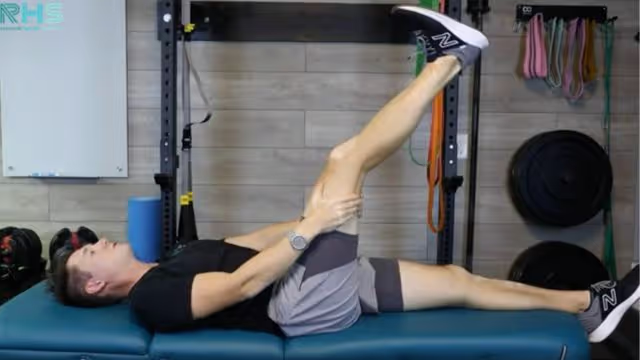
As you kick you leg up, pull your toes back. If you feel burning or pain while pulling your toes back, that can be very normal. I would suggest limiting the range so that you feel it, but not too much. As you continue to do more reps, it will loosen up. Repeat this for 20-30 reps on each side.
Downward Dog with Nerve Glide

Conclusion
In conclusion, a pinched nerve in the lower back can be extremely painful, but it does get better!
Despite this pain, in most cases movement is safe and encouraged to help reduce the pain. The stretches outlined in this article can be the start of a restoration of movement and true reduction in that nagging leg pain. Remember when doing these stretches to focus on the movement of the pelvis. It can feel awkward at first, but sticking with it will make you a pro in no time.
Exercise can be an effective method for alleviating pinched nerve pain, but it requires a precise approach tailored to individual needs. Consistency, proper technique, and listening to your body's signals are crucial to seeing improvements. While not everyone may experience complete relief, many find significant benefits through targeted exercises like nerve glides and stretching routines. Trust in the process and collaboration with a physical therapist can enhance recovery and provide a supportive environment for healing.
References
Quickly Relieve Your Pain From a Pinched Nerve in Your Lower Back in These 5 Simple Stretches:
- Pelvic Tilt
- Cat Camel
- Double Knees to Chest
- Lying Prone
- Prone Press
Nerve pain can be very uncomfortable! With this type of pain can feel so intense and sometimes unpredictable. Often times, my clients think it feels like sciatica.
What Are the Best Stretches for a Pinched Nerve in the Lower back?
Stretches for a pinched nerve in the lower back can be an effective way to treat the pain that is felt down the leg. The tissue that surrounds the nerve can cause compression, leading to pain. Stretching the muscle that may be causing the pinch can lead to relaxation and a reduction in symptoms. I have had many patients that come into the clinic with low back pain, yet their main issue is that the pain runs down the back of their leg. Most doctors put a general label of “sciatica” as a diagnosis, although it can be much more complex.
1. Pelvic Tilt

Position yourself laying down on your back with your knees comfortably bent. From here, the goal is to rotate the pelvis back. Think about the front of your hip bones “tilting” back or dumping out a bowl of fruit from your pelvis. This creates a rocking motion and helps mobilize the hips and lumbar spine.
2. Cat Camel

This exercise starts while on the hands and knees. Do your best to keep your arms and hands under your shoulders and knees in line with the hips. Similarly to the pelvic tilt, position the pelvis so that it tilts backwards. This will bring the back up like a cat arching their back. Start with a small range to determine how well it can be tolerated. Remember, the symptoms down the leg should not get worse. If they do, be sure to stop the exercise and move on to the next. Expect there to be some discomfort in the back, but no increase above baseline leg pain.
3. Double Knees to Chest

Start by laying on your back with the knees bent and feet flat on the ground. Start with one leg or both depending on what feels good for your body. Bring the knees up towards the chest and try to grab them to add over pressure. This brings the spine into a flexed position. This is a great movement to follow up the pelvic tilt.
4. Lying Prone

The set up for this exercise starts with just laying flat on your stomach. This brings the back into extension, which is the opposite of bending forward. This may be an uncomfortable movement at first but can be beneficial to restore mobility. This position can be progressed by placing pillows under the arms, which pushes the back further in extension. Once again symptoms down the leg should not increase above their baseline.
5. Prone Press

Once you have mastered the “lying prone” exercise, you can progress to the prone press up. This exercise pushes the lower back further into extension. It is good to start by just raising up on your elbows and pressing up from there. Expect to feel some pressure in the low back, but still don’t want to feel anything running down the leg. This can be progressed further to pressing up with the arms fully extended. The key to this exercise is to keep your hips down on the table or floor while pressing up the upper half of the body.
Causes of a Pinched Nerve
Typically a pinched nerve comes from two things. There are other causes but they are very rare.
- Disc Herniation: the disc either in the neck or lower back puts pressure onto th nerve root causing pain either in the arm or leg.
- Stenosis: The area around the nerve becomes more narrow and places pressure onto the nerve root causing pain in the arm or leg. Most often in those 60 or older.
If you are curious of how to tell the difference, check out this video.
Symptoms of a Pinched Nerve in the Lower Back
An irritated nerve causes the pain that people refer to as a pinched nerve. Common symptoms include burning, tingling, and radiating pain in the lower back, leg, and foot. That said, it's also not uncommon to only have pain or only have weakness. A detailed physical examination can help you figure that out!

Regardless of the cause of a pinched nerve, the conservative treatment is largely the same to start.
Pain that originates in the lower back and runs down the leg is a very common presentation for physical therapists in the clinic. This is called “radiating” pain because the central cause may be from the back but the symptoms are felt further down the body.
The term used by most people is “sciatica.” It can be caused from disc issues or space issues such as stenosis.
Sciatica refers to a very large nerve that runs from the lumbar spine all the way down the back of the leg and to the foot. Typically, the nerve is irritated at the root where it exits the spine. Other times it can be entrapped near the glutes.
When this nerve is irritated, pain is felt further away from the compression site.
Check out our favorite way to mobilize the sciatic nerve during sessions for specific patients with persistent nerve symptoms that extent outside of their back! The dosing on this one can be a bit tricky, so start slow.
Tight muscles, poor joint mobility, or even a herniated disc can all play a role in pain associated with a pinched nerve.
Is a Pinched Nerve Dangerous?
No, In a majority of cases a pinched nerve is not dangerous. Much of the problems that accompany a pinched nerve is the fear of movement leading to a loss in function.

Many people will get relief when the nerve is mobilized without any detrimental effects.
Long term neglect of a pinched nerve that doesn’t get better can lead to weakness and can even change the way people walk. In addition to poor mechanics while walking, the weakness can make the simplest task difficult.
Getting up out of the chair or going up stairs becomes a laborious task when this happens. This is a rare presentation, but something to watch out for if you’ve had these symptoms for a long time.
How Do You Unpinch a Nerve in Your Lower Back?
The feeling of unpinching a nerve is done by reducing the irritation or inflammation of that nerve. Nerves LOVE to move and NEED to move! Amazingly so, some nerves that are truly occupying a very small space don't hurt. Some nerves that show no signs or very mild signs of "pinching" or "stenosis" can hurt a ton!
The pain comes from inflammation or irritation, not the smaller house that the nerve is living in.
Most of the treatments are centered around a restoration of movement to the spine and the muscles that support it. This article will outline safe and effective movements that can get that stubborn nerve to become unpinched and allow you to live a pain free life!
Can Exercise Cure a Pinched Nerve?
Curing a pinch nerve can be as simple as doing the right exercises as the right time combined with time.
Yes, I have seen many clients report 100% improvement with exercise. I often prescribe nerve glides to assist not only moving the nerve but giving it an environment in which to heal. Here Is the deal. To reduce nerve pain you must follow these rules:
- Stay consistent - It often takes doing these every day for a month to notice a difference
- Listen to your body - They should never make you feel worse
- Do enough reps - 20-30 reps each leg
- Combine with walking program 20-30 minutes a day, everyday

Can You Stretch Out a Pinched Nerve?
You can stretch a pinched nerve. In fact, the evidence says we should do it!
Nerves are made to be stretched, pulled, and even compressed. Like everything else when it comes to our body, it's about how you stretch, what you stretch, and how much you do it. That's were the skill of physical therapist can come in handy. When you combine evidence based stretches with learning your body, the outcomes are great.
My favorite nerve stretch is the downward dog with the nerve glide. Downward dog is a great position for a nerve glide. It helps to move the nerve and provides an environment for healing. Plus you can do both sides quickly!
Where Should I Start for Stretching my Lower Back from a Pinched Nerve?
Start in the small ranges your body can tolerate and expand as you are able to do more. These movements provide a framework that will get nerve moving again and ultimately restore lost function. I find it best to start with stretching that targets the spine, as this tends to be the most common compression site.
The sciatic nerve exits the spine and supplies the hips, legs, and feet.
This is why an issue with the lower back can be felt all the way down in the lower leg and feet.
Want to learn more about the relationship between hip pain and lower back pain? Check out 6 Simple Stretches For Lower Back Pain and Hips
Should You Stretch a Pinched Nerve in Your Back?
Yes, nerves love three things: blood flow, space, and movement and stretching helps with all of those! The body will often respond to a pinched nerve by tightening up the muscles around the nerve.
This rigidity can cause the nerve not to move as well within the body as it should.
The stretches in this article work together to get the muscles and the nerve moving again and can relieve the pressure that is on the nerve. The stretches are organized in a way that they can be progressed or regressed depending on how irritated the nerve is.
Research indicates that the movement of the tissue around the nerve can have a reduction in pain and an improvement in function.
Low back pain can have a detrimental effect on function. When treating my patients, I do my best to reduce the amount of pain they are experiencing first as a means to restore their lost function. With most patients we see that as function is restored, there are even greater reductions In pain.
Not sure if your back pain is from a pinched nerve or something else? Check out these 10 Best Stretches to Relieve Lower Back Pain that can be coming from other causes.
Why is Early Intervention Important?
Long term compression of the nerves can lead to weakness and potentially muscle loss in the affected leg. This weakness can throw off how you walk and can lead to further issues down the road including foot, knee, and hip dysfunction.
It may seem counter intuitive, but finding ways to move when the pain starts can help improve function both in the short and long term.
There are people who respond well to extending the spine, while others may get relief with flexing it.
You can ask yourself, does it feel better when I bed over or when I stand up and lean back?
This can be helpful to determine which of these stretches will help the most early on. The reality is that we want our spines to be able to do both flexion and extension. So the end goal is to restore full function in all movements of the back.
2 Bonus Exercises to Fix A Pinched Nerve
Nerve Glide

Start with laying on your back and support the leg in which you have discomfort. Make sure your comfortable and then start to straighten the leg.

As you kick you leg up, pull your toes back. If you feel burning or pain while pulling your toes back, that can be very normal. I would suggest limiting the range so that you feel it, but not too much. As you continue to do more reps, it will loosen up. Repeat this for 20-30 reps on each side.
Downward Dog with Nerve Glide

Conclusion
In conclusion, a pinched nerve in the lower back can be extremely painful, but it does get better!
Despite this pain, in most cases movement is safe and encouraged to help reduce the pain. The stretches outlined in this article can be the start of a restoration of movement and true reduction in that nagging leg pain. Remember when doing these stretches to focus on the movement of the pelvis. It can feel awkward at first, but sticking with it will make you a pro in no time.
Exercise can be an effective method for alleviating pinched nerve pain, but it requires a precise approach tailored to individual needs. Consistency, proper technique, and listening to your body's signals are crucial to seeing improvements. While not everyone may experience complete relief, many find significant benefits through targeted exercises like nerve glides and stretching routines. Trust in the process and collaboration with a physical therapist can enhance recovery and provide a supportive environment for healing.
References
1. Su, Y., & Lim, E. C. (2016). Does Evidence Support the Use of Neural Tissue Management to Reduce Pain and Disability in Nerve-related Chronic Musculoskeletal Pain?: A Systematic Review With Meta-Analysis. The Clinical journal of pain, 32(11), 991–1004. https://doi.org/10.1097/AJP.0000000000000340
2. George, S. Z., Fritz, J. M., Silfies, S. P., Schneider, M. J., Beneciuk, J. M., Lentz, T. A., Gilliam, J. R., Hendren, S., & Norman, K. S. (2021). Interventions for the Management of Acute and Chronic Low Back Pain: Revision 2021. The Journal of orthopaedic and sports physical therapy, 51(11), CPG1–CPG60. https://doi.org/10.2519/jospt.2021.0304




%20Blog%20thumbnails%204.avif)
